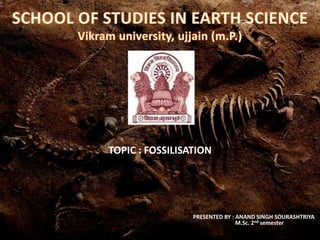
fossils ppt-1.pptx
- 1. TOPIC : FOSSILISATION PRESENTED BY : ANAND SINGH SOURASHTRIYA M.Sc. 2nd semester
- 2. FOSSILS • Fossils are remains of organisms, both plants and animals which has been preserved within the sedimentary rock beds under favourable geologic conditions.
- 3. FOSSILISATION • Fossilisation is the process of transfer of material from biosphere (organic material) to lithosphere (fossil). • Fossilisation can be defined as the physical, chemical, and biological processes that lead to the preservation of plant and animal remains over time.
- 4. FAVOURABLE CONDITIONS FOR FOSSILISATION • THE ORGANISMS SHOULD HAVE HARD PARTS: The hard parts of organisms such as shells, bones, teeth and wood take more time to break down and can be preserved as fossils. • RAPID BURIAL OF ORGANISMS AFTER DEATH UNDER A THICK COVER OF SEDIMENTS: If the organisms are quickly buried under the sediment, it cuts the supply of oxygen and prevents destruction of the organisms by scavengers and decay. • ENVIRONMENT: The environment plays an important role in the organism’s ability to fossilise . It has been observed that marine organisms are more likely to be fossilised than those living on land (Milsom and Rigby, 2010) because marine organisms have greater chance of being covered rapidly by sediments, which increases the chance of fossilisation.
- 5. PROCESSES OF FOSSILISATION • i) Unaltered soft parts or exceptional preservation • ii) Unaltered hard parts preservation • iii) Altered hard parts preservation, which is further divided into • (a) Permineralisation or petrifaction • (b) Carbonisation • (c) Molds and casts • (d) Tracks and trails
- 6. I) UNALTERED SOFT PARTS OR EXCEPTIONAL PRESERVATION • In very rare and ideal situations, the whole of the organism including its soft and hard parts may be found to have been preserved. In this type of preservation, the most fragile and delicate soft parts remain unaltered and provide finer details of the soft parts. This type of preservation takes place in several ways such as fossils preserved in amber, tar or ice.
- 7. Baltic amber stone with fossil inclusion- Trichoptera, Caddisfly.
- 8. “Lyuba”, was discovered along the Yuribey river on the Yamal peninsula, northwestern Siberia
- 9. II) UNALTERED HARD PARTS PRESERVATION • Many invertebrates possess hard parts made up of stable compounds such as calcium carbonate, calcium phosphate and silica. It has been found that many shells and skeletons of invertebrates were preserved in the sedimentary rocks with no alteration in their hard parts.
- 11. III) ALTERED HARD PARTS PRESERVATION • (A) Permineralisation or Petrifaction: It is a slow process and involves the removal of organic material by mineralised solution. Petrifaction is a very slow process in which replacement occurs molecule by molecule. As a result, very fine details about the organisms get preserved.
- 13. (B) CARBONISATION : In this process, the soft-bodied animals as well as the stems and leaves of plants buried under the sediments are decomposed or pressed and thus losing hydrogen, nitrogen, oxygen and other volatile constituents. As a result, a thin carbon film is left behind. Such films are enriched in carbon and appear as black shiny fossils.
- 15. (C) Molds and Casts : This process involves the natural duplication of the original organisms. When a shell gets buried in sediment, subsequently, the sediment becomes hard. At the same time the water running through the sediment may dissolve the shell completely, leaving behind an impression or a void of the shell. Such an impression is known as mold. If the void is filled with grains of sand or clay, it hardens and produces a replica of the original shell shape, which is known as cast.
- 18. (D) TRACKS AND TRAILS: While moving on the soft ground such as mud and sand, the organisms may leave behind impressions of their movements . For example, the foot prints and burrows are preserved when the soft ground materials harden in rock. These types of fossil impressions are also described as trace fossils.
- 19. Thalassinoides, burrows Climactichnites trails Fossilized human footprints Dinosaur footprints